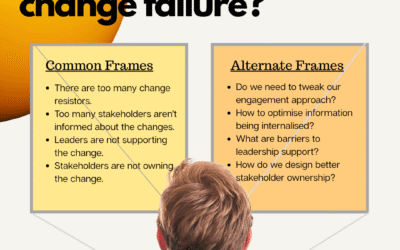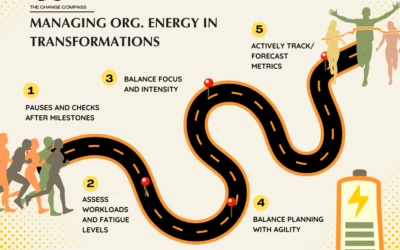A lot of change management approaches are based on viewing change as negative and how to manage this negative experience. The super popular Kubler-Ross model was used to explain the grieving process and later became adopted as a change model. Kubler-Ross developed this model after observing the emotional transition of terminally ill patients, from shock, denial, anger, depression, acceptance and integration. Since then the change curve has been used to cater to all types of change.
John Kotter’s 8-step model of leading change also begins with a potentially negative context of creating a sense of urgency. The context is … if the organization does not do ‘A’ then ‘B’ will happen. The thinking is that providing this context of what negative things will come if we don’t act, we can get traction on building the impetus for change. Step 5 is about enabling action by removing barriers and friction – anticipating and working on these obstacles will enable change success.
Moreover, the language we use in change management tends to be about managing negative incidents. A key focus we have is about anticipating and managing employee and stakeholder resistance. Another focus is on ensuring that senior managers are reinforcing and driving down the message. The idea is that without the hierarchical charge and push change will not be adopted by employees.
Yes, many of our changes can be perceived as negative by impacted parties, e.g. restructuring, outsourcing, and system replacement. However, there is opportunity for us to adopt a more positive approach to inspire change, versus aiming to manage the negative aspects of change.
When I was working a psychologist I remember meeting Martin Seligman when he was visiting Sydney, Australia. Martin Seligman is the father of positive psychology. He broke away from the traditional psycho-analytical approach to psychology that focused on studying mental illness. Instead, he was more interested in studying healthy and well-adjusted people. The basis is that, if we can better understand how healthy traits are fostered (for example, the study of happiness or being positive), then we can better contribute to the health and well-being of everyone.
So how do we practice positive change management? By simply applying Martin Seligman’s PERMA model. In ‘Flourish’ (2011) he proposed the PERMA model for achieving positive well-being: Positive Emotions, Engagement, Relationships, Meaning and purpose, and Accomplishments.
- Design in Positive emotions in the change process. These include excitement, pride, awe, etc. Instead of creating a burning platform through instilling fear and despair, focus on building hope and excitement. In selling the vision of change, leaders and change agents can focus on inspiring change and describing what can be gained at the end of the journey and how this benefits the audience. Celebrating successes along the way can also be a way of building positive emotions throughout the change journey.
- Engagement means being involved in activities that someone is interested in. In the change context, we should work to leverage the interests and passions of various employee and stakeholder groups. Broad engagement is important, but as important is to match the interest and type of involvement of stakeholders. For example, if we are implementing a process change, we may want to involve those who have given feedback about the current process or even have proposed options to the existing process. This may also be applied to customer feedback. Customers who are engaged and interested in product improvement may be leveraged to build and design the change.
- Relationships are identified as critical in building positive emotions. Within a change context, we should work on identifying and leveraging relationships to proliferate and support the change. This includes online platforms such as intranet and Yammer, as well as the relationships of team, business unit and communities of practice. All these are potential relationship platforms to spread the change message and generate support, excitement and positivity. Instagram and Facebook posts can also be examples of this.
- Meaning refers to purpose, or the ‘why’. Linking the change to a greater good beyond the immediate people involved is critical to instill ‘meaning’. This aims to link as much as possible, a higher purpose of the why of change. Ideally, it is not just about making more money or being more efficient, but doing what’s right by the customer, or by the community, for example. It may be linking the change to the organization’s charter and purpose. This greater good is much more motivating for people.
- Accomplishments refer to the activation of positive emotions such as pride that come with achievements and mastery. The sense of achievement can be either at an individual, team or organizational level. During the change rollout process, calling out and celebrating accomplishments is key. Acknowledgments should be made at all levels, individuals, teams, and business unit levels.
When there is a lot of change going on in an organization, significant opportunities present. There is opportunity to look at the total change picture and draw linkages to the same ‘why’ amongst different change initiatives. This linkage amongst different initiatives strengthens the meaning and purpose of the change. In the same way, employee and customer groups may be engaged for a range of change initiatives that may be complementary and tap on the same interest and desires of the groups involved. Accomplishments may also be celebrated across the quarter or the month if there were significant changes that were achieved. To find out how to use data to map the change picture to enable these activities, visit www.thechangecompass.com.






